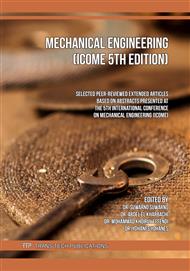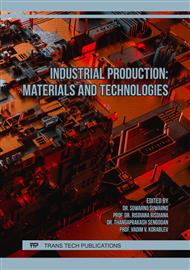[1]
A. le Guen-Geffroy, P. le Gac, B. Habert, P. Davies, Physical ageing of epoxy in a wet environment: Coupling between plasticization and physical ageing, Polymer Degradation and Stability. 168 (2019) 108947.
DOI: 10.1016/j.polymdegradstab.2019.108947
Google Scholar
[2]
X. Xu, S. Gao, D. Zhang, S. Niu, L. Jin, Z. Ou, Mechanical behavior of liquid nitrile rubber-modified epoxy resin: experiments, constitutive model and application, International Journal of Mechanical Sciences. 151 (2019) 46–60.
DOI: 10.1016/j.ijmecsci.2018.11.003
Google Scholar
[3]
M.L. Auad, P.M. Frontini, J. Borrajo, M.I. Aranguren, Liquid rubber modified vinyl ester resins: Fracture and mechanical behavior, Polymer. 42 (2001) 3723–3730.
DOI: 10.1016/S0032-3861(00)00773-4
Google Scholar
[4]
K. Zhao, J. Wang, X. Song, C. Liang, S. Xu, Curing kinetics of nanostructured epoxy blends toughened with epoxidized carboxyl-terminated liquid rubber, Thermochimica Acta. 605 (2015) 8–15.
DOI: 10.1016/j.tca.2015.02.007
Google Scholar
[5]
X. Dong, Z. Wu, Y. Wang, T. Li, X. Zhang, H. Yuan, B. Xia, P. Ma, M. Chen, W. Dong, Toughening polylactide using epoxy-functionalized core-shell starch nanoparticles, Polymer Testing. 93 (2021) 106926.
DOI: 10.1016/j.polymertesting.2020.106926
Google Scholar
[6]
J. Wang, Z. Xue, Y. Li, G. Li, Y. Wang, W.H. Zhong, X. Yang, Synergistically effects of copolymer and core-shell particles for toughening epoxy, Polymer. 140 (2018) 39–46.
DOI: 10.1016/j.polymer.2018.02.031
Google Scholar
[7]
WBCSD, Global ELT Management-A global state of knowledge on regulation, management systems, impacts of recovery and technologies, 2019. www.wbcsd.org (accessed August 20, 2021).
Google Scholar
[8]
L. Bockstal, T. Berchem, Q. Schmetz, A. Richel, Devulcanisation and reclaiming of tires and rubber by physical and chemical processes: A review, Journal of Cleaner Production. 236 (2019) 117574.
DOI: 10.1016/j.jclepro.2019.07.049
Google Scholar
[9]
K. Aoudia, S. Azem, N. Aït Hocine, M. Gratton, V. Pettarin, S. Seghar, Recycling of waste tire rubber: Microwave devulcanization and incorporation in a thermoset resin, Waste Management. 60 (2017) 471–481.
DOI: 10.1016/j.wasman.2016.10.051
Google Scholar
[10]
Ł. Zedler, M. Przybysz-Romatowska, J. Haponiuk, S. Wang, K. Formela, Modification of Ground Tire Rubber—Promising Approach for Development of Green Composites, Journal of Composites Science. 4 (2019) 2.
DOI: 10.3390/jcs4010002
Google Scholar
[11]
A. Hejna, J. Korol, M. Przybysz-Romatowska, Ł. Zedler, B. Chmielnicki, K. Formela, Waste tire rubber as low-cost and environmentally-friendly modifier in thermoset polymers – A review, Waste Management. 108 (2020) 106–118.
DOI: 10.1016/j.wasman.2020.04.032
Google Scholar
[12]
X. Colom, F. Carrillo, J. Cañavate, Composites reinforced with reused tyres: Surface oxidant treatment to improve the interfacial compatibility, Composites Part A: Applied Science and Manufacturing. 38 (2007) 44–50.
DOI: 10.1016/j.compositesa.2006.01.022
Google Scholar
[13]
S. Sugiman, S. Salman, B. Anshari, Hydrothermal ageing of hydrophobic nano-calcium carbonate/epoxy nanocomposites, Polymer Degradation and Stability. 191 (2021).
DOI: 10.1016/j.polymdegradstab.2021.109671
Google Scholar
[14]
ASTM-D638-14, Standard Test Method for Tensile Properties of Plastics, ASTM Standards. 08 (2014) 1–15.
Google Scholar
[15]
Thermo Scientific, Basic organic functional group, reference chart, Www.Thermoscientific.Com/Ftir. (n.d.).
Google Scholar
[16]
J. Coates, Encyclopedia of Analytical Chemistry -IInterpretation of Infrared Spectra, A Practical Approach, Encyclopedia of Analytical Chemistry. (2004) 1–23. http://www3.uma.pt/jrodrigues/disciplinas/QINO-II/Teorica/IR.pdf.
Google Scholar
[17]
C. Kaynak, E. Sipahi-Saglam, G. Akovali, A fractographic study on toughening of epoxy resin using ground tyre rubber, Polymer. 42 (2001) 4393–4399.
DOI: 10.1016/S0032-3861(00)00734-5
Google Scholar
[18]
E. Sipahi-Saglam, C. Kaynak, G. Akovali, M. Yetmez, N. Akkas, Studies on epoxy modified with recycled rubber, Polymer Engineering and Science. 41 (2001) 514–521.
DOI: 10.1002/pen.10748
Google Scholar



